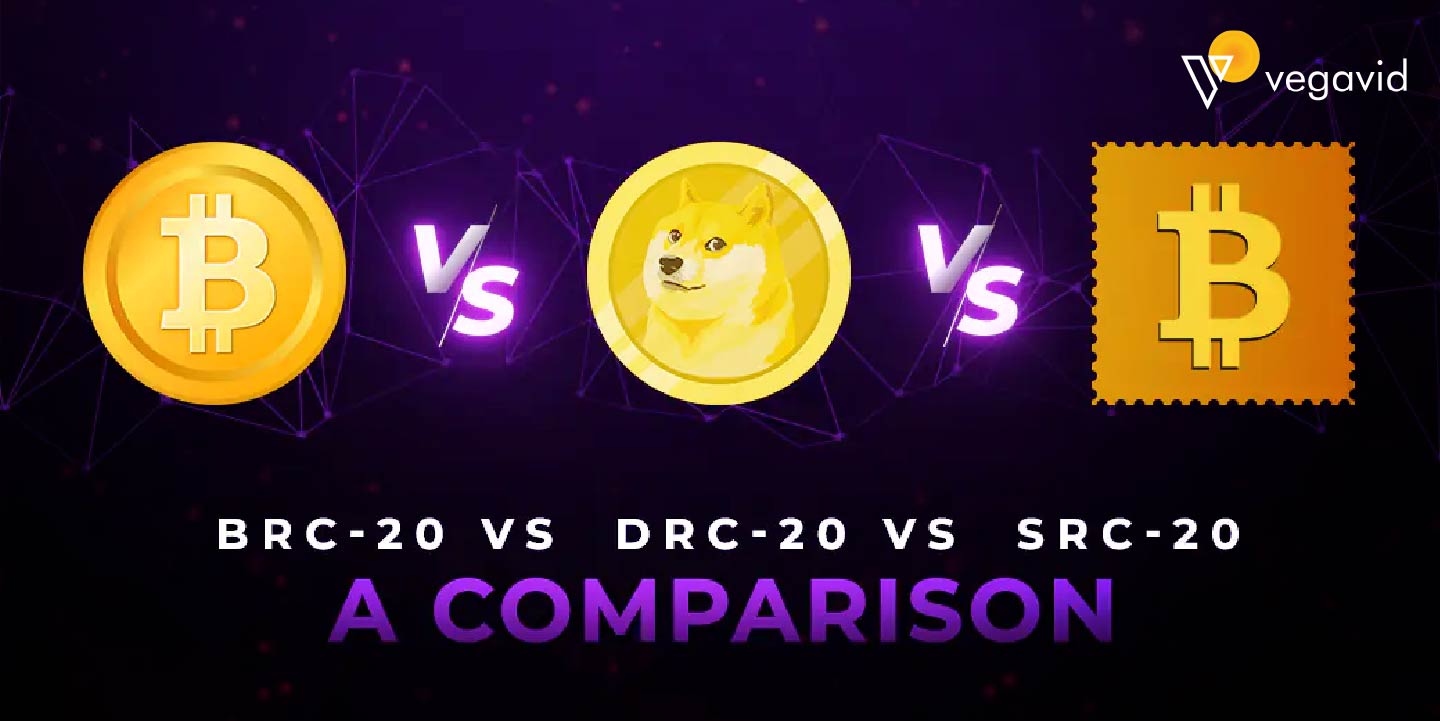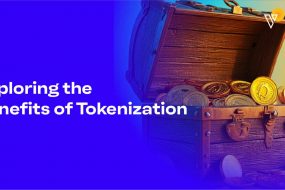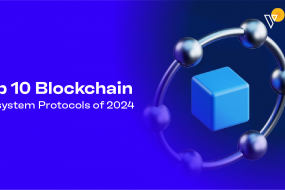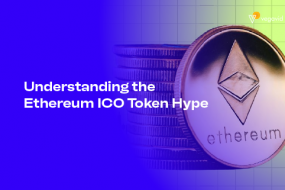
Cryptocurrencies can be confusing with so many different types and standards. For anyone looking to get involved, understanding the main differences between BRC-20 vs DRC-20 vs. SRC-20 is an essential first step. While they all aim to power smart contracts and decentralized applications, each standard has strengths and weaknesses. Let’s take a closer look at how they compare.
BRC-20, DRC-2, and SRC-20 are token standards for unique purposes in blockchain and cryptocurrencies. BRC-20 is associated with the Binance Smart Chain, DRC-20 is specific to Deversifi’s decentralized exchange, and SRC-20 focuses on security token creation. Understanding the differences between these standards is essential for navigating the diverse applications and platforms within the blockchain ecosystem.
A Brief History
The genesis of these standards can be traced back to 2017 with the development of Ethereum and the introduction of the ERC-20 token standard. ERC-20 set the foundation for what a crypto token on the Ethereum blockchain should look like in terms of functions and behaviors. It opened the doors for many other projects to create variations optimized for different needs. The BRC-20, DRC-20, and SRC-20 standards are significant in cryptocurrency and blockchain technology. BRC-20, often called “Blockchain Request for Comments 20,” is a standard for creating fungible tokens on the Binance Smart Chain (BSC).
It is akin to Ethereum’s ERC-20 and has played a pivotal role in the rapid growth of the BSC ecosystem.
DRC-20, or “Deversifi Request for Comments 20,” is Deversifi’s unique standard for token creation on its decentralized exchange. This token standard is specific to Deversifi and allows for seamless trading of various assets on the Deversifi platform. In contrast, SRC-20, or “Securitize Request for Comments 20,” is designed for creating security tokens. Security tokens represent ownership in real-world assets and are subject to regulatory compliance, making SRC-20 a crucial standard for tokenizing assets in a regulated and secure manner. These standards have played a distinct role in shaping the blockchain and cryptocurrency landscape, catering to different use cases and platforms.
What is BRC-20?
Binance Chain created the BRC-20 standard to power tokens on its blockchain. Like ERC-20, it defines a generic permit’s essential functions, such as allowing tickets to be approved and transferred. However, BRC-20 prioritizes fast transaction speeds and lower fees compared to Ethereum. It makes it a popular choice for applications needing quick and affordable transactions. It’s also fully compatible with the Ethereum Virtual Machine (EVM) for easy migration of ERC-20 tokens.
BRC-20 is a token standard specific to the Binance Smart Chain (BSC), akin to Ethereum’s ERC-20. It defines the rules for creating fungible tokens on the BSC, enabling developers to issue and manage digital assets seamlessly. BRC-20 tickets are interchangeable, making them ideal for various use cases, from creating cryptocurrencies to representing assets or rewards. They have played a pivotal role in the growth of the BSC ecosystem, facilitating the development of decentralized applications, decentralized finance (DeFi) projects, and more by providing a common framework for token creation and compatibility across the Binance Smart Chain.
Understanding DRC-20
Like BRC-20, the DRC-20 standard was born out of wanting to build upon ERC-20’s foundation but optimize it for a new blockchain – in this case, DrakenChain. DRC-20 focuses on delivering high throughput, support for validator nodes, and enhanced privacy features. For example, it allows “coin mixing” transactions to obscure a token’s origin and destination. This private functionality opens the door for specialized use cases around confidential transactions. Performance is also a priority, with DrakenChain claiming speeds of over 100,000 transactions per second.
DRC-20, short for Deversifi Request for Comments 20, is a unique token standard specific to the Deversifi decentralized exchange. DRC-20 tokens are designed to facilitate seamless trading on the Deversifi platform, allowing users to exchange a wide range of digital assets securely. While similar in concept to other token standards like ERC-20, DRC-20 is customized for Deversifi’s ecosystem, serving as the foundation for creating and trading various tokens within the exchange and contributing to the diversity and functionality of the platform.
What Makes SRC-20 Unique?
Created for the StarryChain blockchain, SRC-20 is unique because its goal is to support real-world assets on the blockchain. Beyond just being a crypto token, SRC-20 allows issuers to represent physical items using Non-Fungible Tokens (NFTs). It could enable digital collectibles, game items, digital art, and more to exist concurrently on and off the StarryChain network. SRC-20 also features special permissions allowing approved third parties limited access to interact with NFT Smart Contracts. This bridge between the digital and physical worlds through SRC-20 opens exciting opportunities.
Comparing the Standards
In summary, BRC-20, DRC-20, and SRC-20 each bring something new compared to ERC-20:
- BRC-20 focuses on fast, cheap transactions for general use.
- DRC-20 emphasizes high throughput, privacy, and decentralized validation.
- SRC-20 uniquely enables linking real-world physical assets to blockchain-based digital tokens through NFTs.
The choice between them depends on your specific needs – do you prioritize speed, privacy, or representing accurate items digitally? Understanding these fundamental differences in their goals is an essential first step when deciding which token standard best fits your project’s vision. Overall, the growth of BRC-20, DRC-20, and SRC-20 shows the exciting potential behind innovating upon ERC-20’s foundation in new, optimized ways.
It provides a helpful overview of how BRC-20 vs DRC-20 vs. SRC-20 compare and provides friendly context around their subtle but significant differences. Please let me know if any part of the explanation can be improved or expanded. I’m always looking to enhance my knowledge and write helpfully.
Benefits of BRC-20, DRC-20 and SRC-20
In the ever-evolving landscape of blockchain and cryptocurrency, token standards play a crucial role in shaping the functionality and applications of digital assets. Among these standards, BRC-20, DRC-20, and SRC-20 are three distinctive token types, each tailored to specific use cases and platforms. Understanding the benefits and differences between these standards is essential for navigating the vast world of blockchain. This article will explore the advantages of BRC-20, DRC-20, and SRC-20.
BRC-20: Empowering the Binance Smart Chain
BRC-20, or Binance Smart Chain Request for Comments 20, is a token standard that finds its home in the Binance Smart Chain ecosystem. It shares similarities with Ethereum’s ERC-20 but offers distinct advantages. BRC-20 tokens are highly efficient, benefiting from the Binance Smart Chain’s impressive transaction speed and low fees. It is ideal for developers and users seeking fast and cost-effective token transfers. Additionally, BRC-20 tokens enjoy a broad range of interoperability, meaning they can quickly move between the Binance Smart Chain and other compatible networks.
DRC-20: Tailored for Deversifi’s Decentralized Exchange
DRC-20, or Deversifi Request for Comments 20, is a token standard specifically crafted for Deversifi’s decentralized exchange. What sets DRC-20 apart is its focus on optimizing trading within the Deversifi ecosystem. Its benefits become evident when trading on the platform, as it ensures swift and secure asset transfers while offering a high compatibility level with Deversifi’s interface and trading tools. DRC-20 is the backbone of Deversifi’s tokenized assets, enabling users to seamlessly trade a wide array of digital assets within the exchange.
SRC-20: Tokenizing Real-World Assets Securely
SRC-20, or Securitize Request for Comments 20, is a token standard designed to create security tokens. Security tokens represent ownership in real-world assets, such as real estate, stocks, or other financial instruments. What sets SRC-20 apart is its unwavering commitment to regulatory compliance. These tokens are equipped with features that ensure adherence to legal requirements, making them an ideal choice for businesses and individuals looking to tokenize and trade assets securely and competently.
Comparing the Benefits
The benefits of BRC-20 vs DRC-20 vs. SRC-20 are best understood when considered in the context of their respective use cases:
- BRC-20 excels in speed and efficiency. It offers rapid transaction processing and low fees, making it suitable for applications requiring quick transfers and cost-effective transactions. Its interoperability also widens the range of use cases, from DeFi projects to gaming.
- DRC-20 shines in the context of Deversifi’s decentralized exchange. It provides a seamless trading experience within the Deversifi platform, ensuring users can easily trade diverse digital assets. Its compatibility with Deversifi’s ecosystem optimizes the user experience.
- SRC-20 stands out for its security and regulatory compliance. It is the choice for businesses looking to tokenize real-world assets while ensuring adherence to legal requirements. SRC-20 provides the necessary tools to create compliant tokens representing tangible asset ownership.
Conclusion
In blockchain and cryptocurrency, token standards like BRC-20 vs DRC-20 vs. SRC-20 cater to diverse needs and applications. BRC-20 offers speed and efficiency, making it a favored choice for many projects. DRC-20 is tailored for Deversifi’s trading ecosystem, ensuring smooth trading experiences. SRC-20, with its focus on security and regulatory compliance, is the go-to standard for tokenizing real-world assets. Each bar has unique strengths, contributing to the ever-expanding possibilities in digital assets. Understanding these benefits enables users and developers to make informed choices per their specific requirements and objectives.








